
Leptospermum petersonii, commonly known as lemon-scented teatree, is a species of shrub or small tree that is endemic to eastern Australia. It has thin, fibrous or flaky bark, often strongly-scented elliptic to lance-shaped leaves, white flowers and fruit that are retained for several years. It is commonly grown as an ornamental and is regarded as a minor environmental weed in some areas.
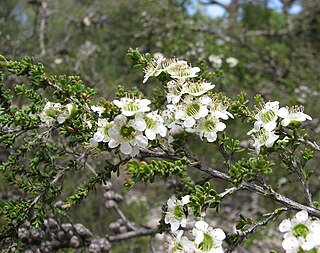
Leptospermum liversidgei, commonly known as the olive tea-tree, is a species of compact shrub that is endemic to eastern Australia. It has narrow egg-shaped, lemon-scented leaves, white or pink flowers and woody fruit that remain on the plant at maturity.

Sannantha is a genus of flowering plants in the family Myrtaceae that are native to Australia and New Caledonia. Plants in the genus Sannantha are shrubs or trees with leaves arranged in opposite pairs, flowers usually arranged in small groups, the peduncles often 1.5–2 times as long as the pedicels and with seven to fourteen stamens. The fruit is a thin-walled capsule containing flattened, D-shaped seeds. Some species of Sannantha were previously included in the genus Babingtonia.

Baeckea brevifolia is a species of flowering plant in the family Myrtaceae and is endemic to south-eastern New South Wales. It is a shrub with narrow egg-shaped to oblong leaves and white to pink flowers with nine to fifteen stamens.

Sannantha virgata is a flowering shrub species in the myrtle family, Myrtaceae. It is endemic to New Caledonia. Plants grow to between 0.5 and 3 metres high. White flowers appear in spring or summer with 5 rounded petals surrounding 7 to 10 stamens. The fruits are 1–2 mm wide and 2–3 mm in length.
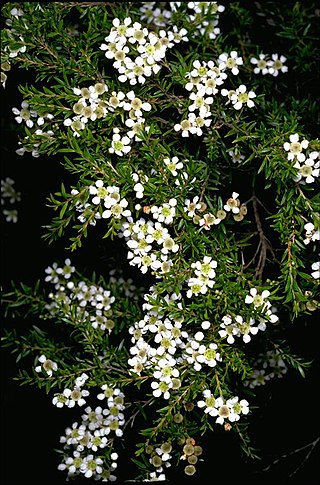
Sannantha similis is a species in the myrtle family, Myrtaceae and is endemic to eastern Australia. It is a shrub with narrowly lance-shaped leaves, and groups of three white flowers arranged in leaf axils.
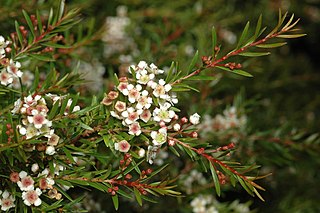
Sannantha bidwillii is a species in the myrtle family, Myrtaceae and is endemic to coastal Queensland in Australia. It is a shrub or tree with elliptic to egg-shaped leaves with the narrower end towards the base, and clusters of 3 white flowers.
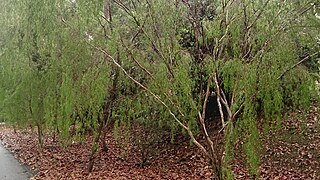
Leptospermum madidum is a species of shrub or small tree that is endemic to north-western Australia. It has weeping branches, smooth bark, pale green linear leaves, small white flowers and thin-walled fruit.

Leptospermum brevipes, commonly known as the slender tea-tree, is a species of shrub or small tree that is endemic to eastern Australia. It has fibrous bark on the main stems, smooth bark on young stems, narrow elliptical to narrow egg-shaped leaves, white flowers and hemispherical fruit that is shed when mature.
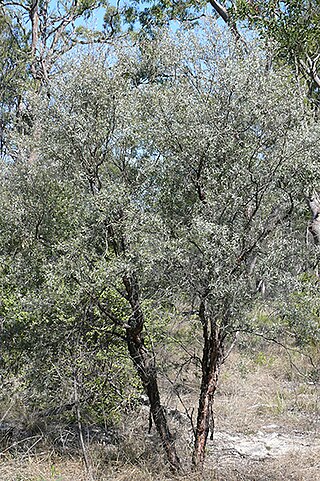
Leptospermum lamellatum is a species of shrub or small tree that is endemic to inland Queensland and has distinctive reddish, layered bark. It has narrow elliptical leaves, white flowers and small fruit that fall from the plant when mature.
Leptospermum pallidum is a species of spreading shrub that is endemic to Queensland. It has thin, firm, rough bark, narrow lance-shaped leaves, white flowers arranged in groups of two or three on side shoots and fruit that remains on the plant until it dies.

Triplarina imbricata, commonly known as creek triplarina, is a species of flowering plant in the myrtle family, Myrtaceae and is endemic to northern New South Wales. It is a shrub with weeping branches, narrow egg-shaped leaves, and flowers in pairs with five sepals, five relatively small white petals and fourteen to seventeen stamens.
Sannantha angusta is a species of flowering plant in the family Myrtaceae, and is endemic to eastern Australia. It has scaly to fibrous bark, narrowly lance-shaped to linear leaves and white flowers, and usually grows in forest on rocky hillsides. It was previously known as Babingtonia angusta, and has been cultivated as Baeckea sp. 'Clarence River'.
Sannantha brachypoda is a species in the myrtle family, Myrtaceae and is endemic to central Queensland in Australia. It is a shrub with egg-shaped leaves, the narrower end towards the base, and groups of 3 white flowers arranged in leaf axils.
Sannantha collina is a species in the myrtle family, Myrtaceae and is endemic to eastern in Australia. It is a shrub with lance-shaped leaves and groups of 3 to 7 white flowers arranged in leaf axils.
Sannantha crassa is a species in the myrtle family, Myrtaceae and is endemic to eastern Australia. It is a shrub with elliptic to lance-shaped leaves and groups of 7 to 9 white flowers arranged in leaf axils.

Sannantha crenulata, commonly known as fern-leaf baeckea, is a species of flowering plant in the myrtle family, Myrtaceae and is endemic to a restricted part of Victoria in Australia. It is an erect shrub with egg-shaped to round leaves with scalloped edges, and groups of usually 3 white flowers arranged in leaf axils.
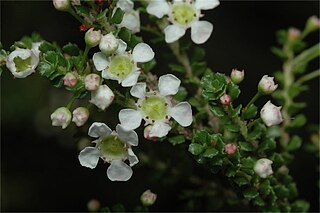
Sannantha cunninghamii is a species of flowering plant in the myrtle family, Myrtaceae and is endemic to eastern New South Wales. It is a shrub with round to broadly elliptic leaves with irregular edges, and white flowers arranged singly, in pairs or groups of three in leaf axils.
Sannantha papillosa is a species in the myrtle family, Myrtaceae and is endemic to north Queensland. It is a shrub with egg-shaped leaves, the narrower end towards the base, and groups of usually 7 white flowers arranged in leaf axils.
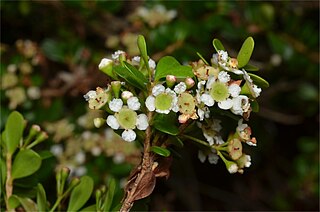
Sannantha tozerensis is a species of flowering plant in the myrtle family, Myrtaceae and is endemic to a small area of Cape York Peninsula in north Queensland. It is a shrub with elliptic to egg-shaped leaves, the narrower end towards the base, and white flowers arranged in groups of three or seven in leaf axils.














